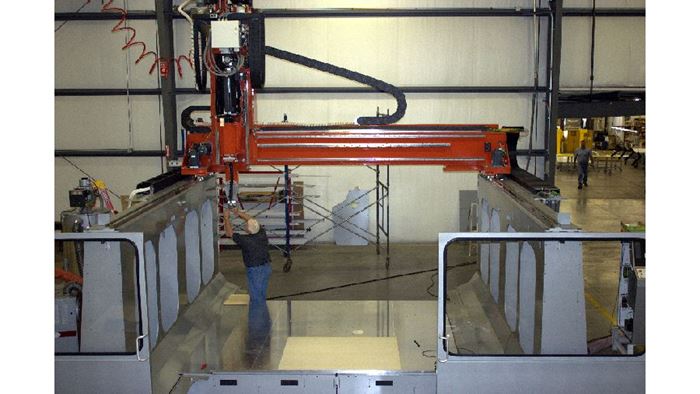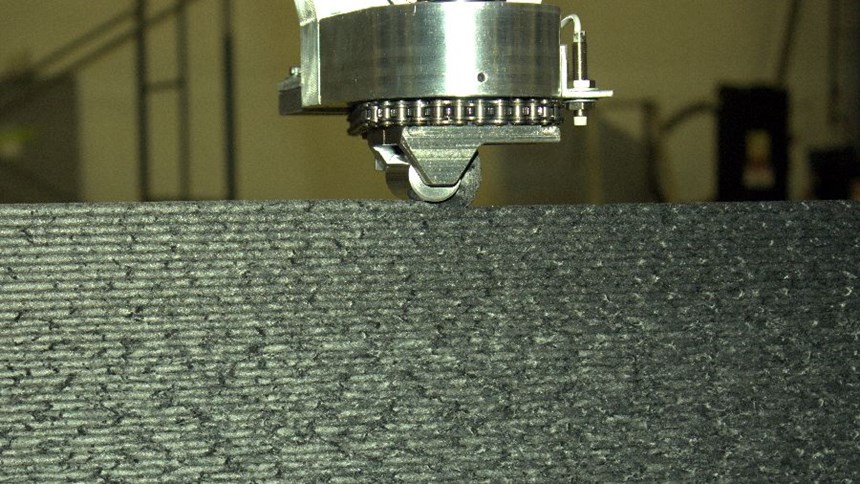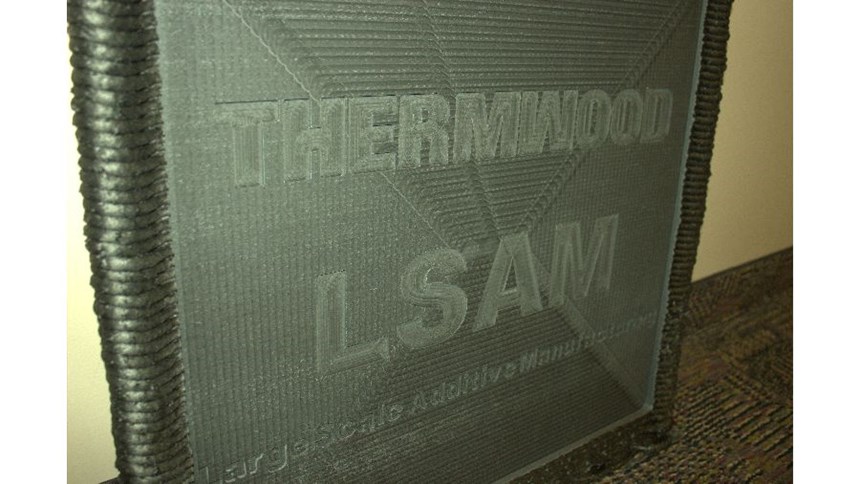Developmental LSAM Machine Adds Melt Shaping Capability
Development continues on Thermwood’s Large Scale Additive Manufacturing (LSAM) machine with the inclusion of a shaping wheel and plans for subtractive integration.
Melt shaping, or the ability to modify heated material before it hardens, can be used to control the shape and thickness of an additive layer and help to avoid larger problems like delamination later. This concept will be important to the Large Scale Additive Manufacturing (LSAM) system currently being developed by Thermwood Corp. for large commercial applications.
Thermwood, a manufacturer of CNC routers, is collaborating with American Kuhne on the project, which was first announced over the summer. American Kuhne supplied a custom 1.75"-diameter vertical extruder for the developmental machine, which is built on the semi-enclosed Thermwood Model 77 gantry structure with capacity for printing parts ranging to 10 × 10 × 5 feet.
The goal is to develop a high-volume thermoplastic 3D printer that can achieve near-net shape accuracy on large parts. Melt shaping is a means of controlling the printer’s output toward this end. The developmental machine is equipped with what the developers call “MeltShape Technology,” an approach that uses a shaping wheel (or wheels) to shape, form and compress the hot plastic melt as it is extruded. This strategy helps to ensure that each new layer is the proper shape and thickness, and that it bonds firmly to the layer below.
Rolling the material under the shaping wheel also squeezes out air that could otherwise become trapped between layers. Pockets of trapped air can cause additive parts to delaminate inside a heated autoclave, as is often required for aerospace parts and patterns. According to Thermwood, the melt shaping capability resulted in virtually void-free walls during recent testing with 20 percent carbon-graphite-filled ABS from Techmer ES. Other material tests are in the works; Thermwood is also considering the possibility of different shaping wheels that could impart specific characteristics to the hot plastic bead.
The shaping wheel is servo-controlled to follow the motion of the five-axis machine, which is capable of building layers in any direction up to 90 degrees from the horizontal plane including on curved surfaces. A “tangential following” feature within the Q Core CNC control keeps the wheel aligned with machine motion so that six-axis programming is not necessary.
The developmental machine will be equipped with a five-axis subtractive gantry trim system in the next several months, which will enable the system to additively build parts to near-net shape and then machine them to the exact final shape. Thermwood eventually plans to offer this second, subtractive gantry as an option on LSAM machines for sale. The company has not indicated when the systems will be available for purchase, but plans to continue working with material vendors, R&D operations and potential users to refine the technology.
Related Content
-
3D Printed Preforms Improve Strength of Composite Brackets: The Cool Parts Show Bonus
On this episode, we look at a pin bracket for the overhead bin of an airplane made in two composite versions: one with continuous fiber 3D printed reinforcements plus chopped fiber material, and one molded from chopped fiber alone.
-
3D Printed Spares, Electrification and Cool Parts: Top 10 Stories of 2022: AM Radio #31
Our top articles and videos from 2022 reflect increasing use of additive manufacturing for replacement parts; growing applications for electric motors; and a maturing user base. Read through the top 10 list or listen to the AM Radio podcast episode all about these stories.
-
Next-Gen Horse Trailers to Be Built With Robotic 3D Printing
Double D Trailers is currently developing a prototype horse trailer that will be made with large-format additive manufacturing. The technology brings potential benefits for labor, weight and design features to this subset of recreational vehicles.

.jpg;width=70;height=70;mode=crop)
















